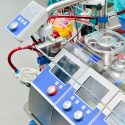Development Year: 1953
Inventor: John Gibbon
Description: The heart-lung bypass machine, also known as a cardiopulmonary bypass machine, is a critical piece of medical equipment used during open-heart surgery. It temporarily takes over the function of the heart and lungs during the procedure, ensuring that oxygen-rich blood continues to circulate throughout the patient’s body.
Functionality: This machine oxygenates the blood and removes carbon dioxide, akin to a lung’s function, while also pumping the blood, thereby substituting for the heart’s pumping action. By doing so, it allows surgeons to operate on a still and blood-free heart, making complex cardiac surgeries, such as coronary artery bypass grafting, valve repair, or heart transplants, feasible and safer. The use of this machine is pivotal in modern cardiac surgery, significantly improving surgical outcomes and patient survival rates.
Source: https://www.acc.org/Latest-in-Cardiology/Articles/2019/06/19/06/46/The-History-of-Cardiopulmonary-Bypass

